| The Standard Report Creation Wizard is the most frequently used design assistant in Crystal Reports. It provides multiple dialogs common to creating reports that are based on conventional corporate data sources. The Standard Report Creation Wizard guides you through selecting a data source, linking data source tables, adding data source fields to the report, specifying field groupings, identifying summary (total) fields, and setting the desired sort criteria for your report. Additionally, the Standard Report Creation Wizard walks you through creating chart objects, applying record selection criteria (data filters), and applying predefined templates (layouts) to your report. Note The term filter is commonly used to describe data selection criteria that narrow the scope of the data being extracted by the report from the underlying data source. For example, by using a filter such as Country = USA, you can easily limit your report to include only the information you are interested in extracting.
The Standard Report Creation Wizard consists of nine dialog screens that enable you to specify the criteria mentioned previously to create a professional-looking report quickly. The sequence of the wizard's dialog screens is dynamic and directly associated with the items selected in each of the progressive screens. For example, if you do not choose to identify any summary items for your report, you will not be presented with a Chart dialog screen. In general, charts apply best to summarized data, so if you have not identified any summary fields, the wizard assumes that you do not want to include a chart object in your report. Note Charts can also be created from base-level data, although to do this you must appropriately specify the On Change Of option and use the Advanced settings with the Chart Expert. Generally, it makes more sense to base chart objects on summary-level data, such as regional sales by quarterwhere you are charting the total sales for each quarter rather than each sales transaction in each quarter.
The following exercise steps through the wizard and builds a sales report to display last year's sales by country. By making use of the Standard Report Creation Wizard, you include the country, city, customer name, and last year sales database fields, graphically display a summary of last year sales by country, and apply professionally styled formatting to the report. To create the sales report, follow these steps: 1. | From the main File menu, select the New option, and then select the Standard Report Wizard from the wizard list.
| | | 2. | As shown in Figure 1.13, you should now be presented with the first dialoglabeled Dataas part of the Standard Report Creation Wizard. From the Data dialog screen, expand the Create New Connection node and then expand the ODBC listing as well. This should present the ODBC Data Source Selection dialog.
Figure 1.13. The Standard Report Creation Wizard begins by requesting a data source for your report. 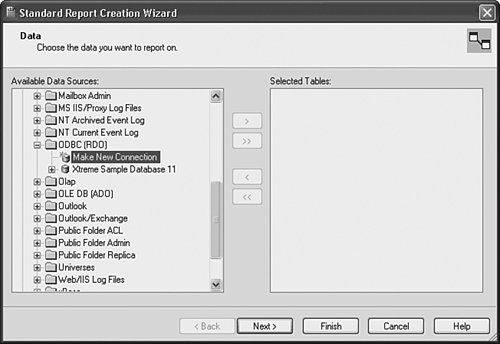
| 3. | From the ODBC Data Source Selection dialog, scroll to the end of the Data Source Name list and select Xtreme Sample Database 11, as shown in Figure 1.14. Click Next to continue.
Figure 1.14. The ODBC Data Source Selection dialog enables you to select a valid connection to access your ODBC data sources. 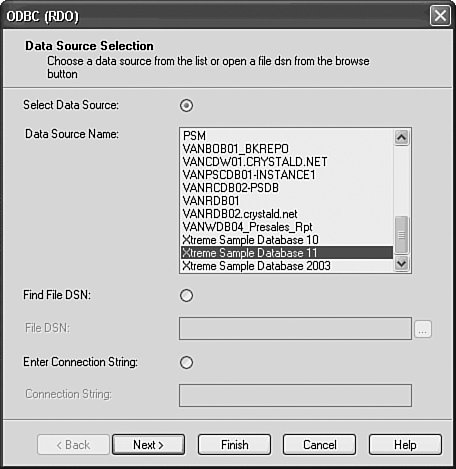
| 4. | Verify that the Data Source Name is correct and click Finish from the ODBC Connection Information dialog. No password is necessary to access this database.
| | | 5. | After you have successfully identified and connected to Xtreme Sample Database 11, you should see this item listed under the ODBC node in the Available Data Sources area of the Data dialog screen, as shown in Figure 1.15. Upon expanding the Xtreme Sample Database 11 item, you should see three or four distinct data source items listed: Tables, Views, and Stored Proceduresand possibly System Tables, dependent on your options settings (shown in Figure 1.16).
Figure 1.15. The Xtreme Sample Database is listed under the Available Data Sources area of the Data dialog. 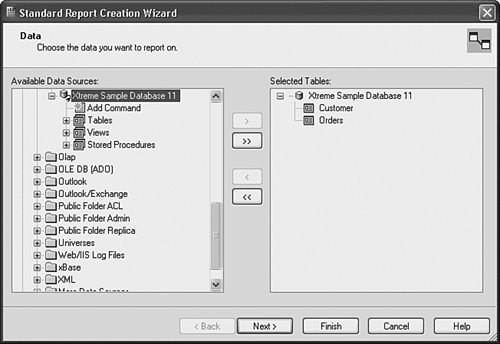
Figure 1.16. Upon expanding the Xtreme Sample Database 11 item, you will notice multiple database items listed. 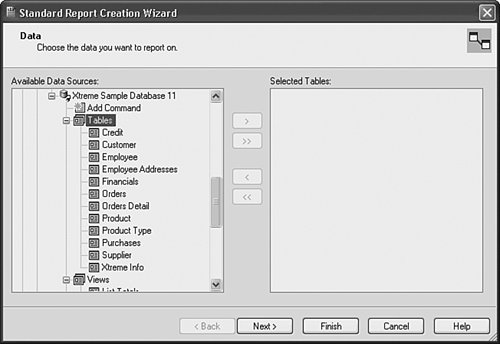
| 6. | Within the Data dialog screen, select the Customer and Orders tables so that they are listed in the Selected Tables area on the right. After these two tables are selected, click Next to continue on to the Linking Dialog.
Tip There are multiple ways to include tables in your report from within the Data dialog screen. From the list of available tables on the left side of the dialog, you can perform any one of the following actions to populate the Selected Tables list on the right side of the dialog area: Double-click on each desired table item Drag-and-drop each desired table item Highlight the table item on the left (or multiple tables by using Ctrl-click) and click on the respective arrow icon (> or >>) between the two listing areas to populate the listing on the right
| | | 7. | The Link dialog screen presents a visual representation of the relationship between these two tables and permits you to modify the defined relationship by specifying the exact Join links that you require to accurately report on the data within the selected tables. As shown in Figure 1.17, you should now see the Link dialog screen. For our purposes here, accept the default Join condition. Click Next to continue.
Figure 1.17. The Customer and Orders tables are linked together via the Customer ID field. 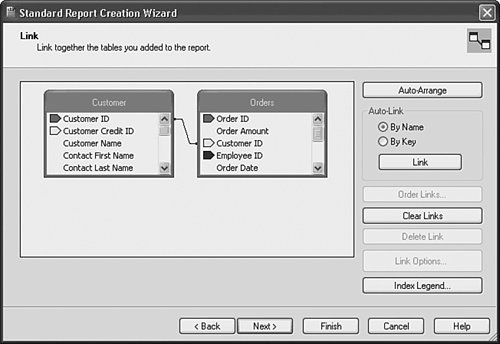
| | | 8. | After specifying the table linking, you will see the Fields dialog screen, shown in Figure 1.18. Select the Customer Name, Country, and City fields from the Customer table and the Order Amount and Order Date fields from the Order table so that they appear under the Fields to Display area on the right. If necessary, you can use the up and down arrows to modify the order of these fields in the list. Click Next to continue.
Figure 1.18. The Customer Name, Country, City, Order Amount, and Order Date fields should appear under the Fields to Display area. 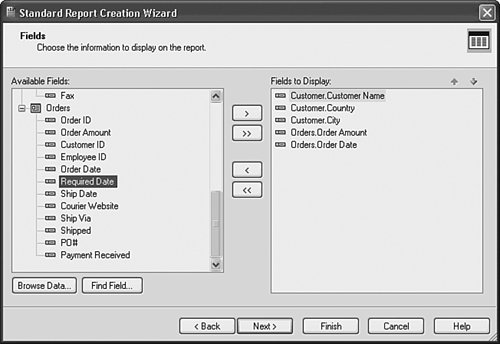
Note If you're not sure of the data contained in any of the respective field items on the left, you can highlight a field name and click the Browse Data button to view a list of values from this field, as shown in Figure 1.19. This can be particularly useful if you are unfamiliar with the database and need to locate a field based on the values it contains, such as account numbers, policy codes, or employee names. Figure 1.19. The Browse Data button enables you to view a list of values from any of the available database field items. 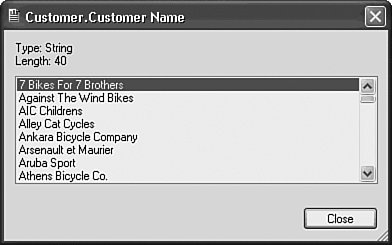
| 9. | You should now see the Grouping dialog screen. This dialog enables you to specify logical groups of information within your reports. For this example, select to group by the Country field only, as shown in Figure 1.20. Click Next to continue.
Figure 1.20. The Grouping dialog enables you to create structured groupings of information within your report. 
| | | 10. | You should now see the Summaries dialog screen. The Summaries dialog screen enables you to identify summary values (such as Sums, Counts, and so on) for your reports. If you have not identified any grouped items in a report, the Summaries dialog does not appear because summaries are only applicable to grouped data. To apply a summary object to the report, select the Order Amount field so that it appears under the Summarized Fields list on the right. This is shown in Figure 1.21. Click Next to continue.
Figure 1.21. The Summaries dialog screen enables you to create summarized values that are frequently used in coordination with the grouping structure within reports. 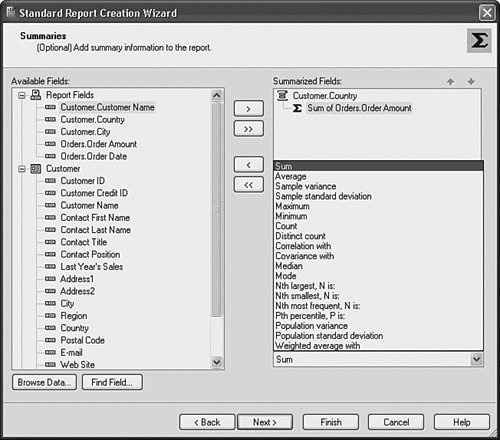
Note As you might notice, Crystal Reports automatically chooses a summary for you if you choose to group your report data. It examines the detail information you've specified for the report and builds a summary on the first available numeric field. However, this default summary criteria is easily modified in the wizard. Note By default, the Order Amount field that appears under the Summarized Fields area on the right is aggregated as a Sum of the actual field value. As shown in Figure 1.21, the drop-down list located in the lower-right area of the Summaries dialog screen enables you to select from a variety of summaries, including Sum, Average, Maximum, Minimum, Count, Correlation, Covariance, and Standard Deviation. | | | 11. | Now sort the report based on the total order amounts of the top five countries. The Group Sorting dialog screen enables you to sort the grouped fields based on the summarized totals. From the Group drop-down list, select the Country field (the only option in the example here) and select the Top 5 Groups option from the Group Ordering choices. Also, select the Sum of Order Amount item (the only option in the example here) from the Comparing Summary Values drop-down list, as shown in Figure 1.22. Click Next to continue.
Figure 1.22. The Group Sorting dialog enables you to sort your report based solely on the Group values you want to include in the report results. 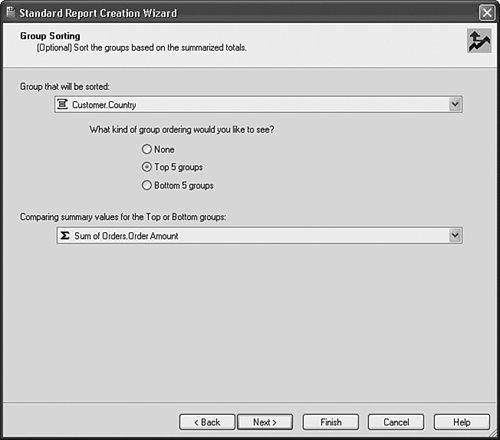
| 12. | Charting can be added through the wizard to visually display the data already selected. From the Chart dialog screen, you can select a chart object to be included in the report based on the group and summary items you identify here. For this example, add a bar chart and select the Country field from the On Change Of drop-down list and the Sum of Order Amounts item from the Show Summary drop-down list. Change the chart title to read Total Order Amounts by Countrysee Figure 1.23 for additional guidance. Click Next to continue.
Figure 1.23. The Chart dialog enables you to select a chart object for a report based on the previously identified group and summary criteria. 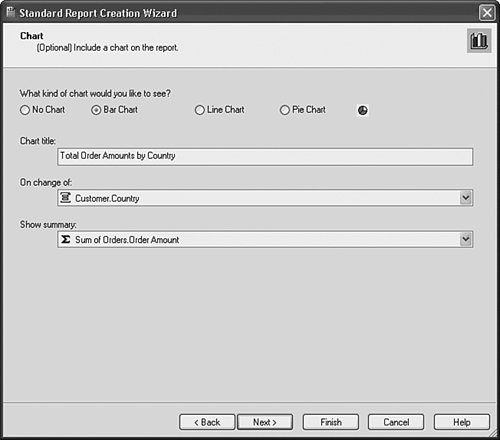
| | | 13. | Now you'll address the fictitious requirement that you are only interested in customer orders from the year 2003. The Record Selection dialog screen enables you to identify selection criteria, often called data filtering, to focus the resultset of the report to include only the information you are interested in returning. To accomplish this, select Order Date as the Filter Field, choose Is Between from the filter operator drop-down list, and select a data range from the newly created date-range drop-down boxes to incorporate all the dates in 2003 (see Figure 1.24). Click Next to continue.
Figure 1.24. The Record Selection dialog permits you to narrow your resultset based on the selection criteria identified here. 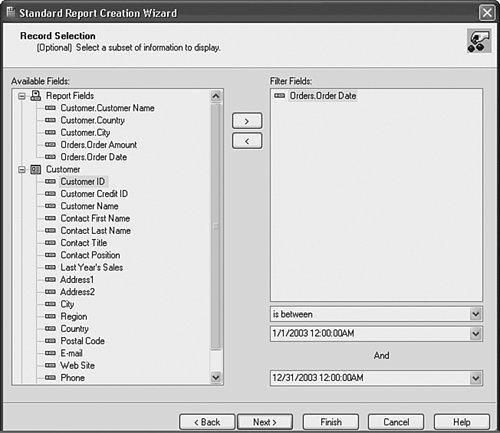
| | | 14. | Finally, apply a predefined style to your report. From the Template dialog screen, you can select predefined styles to be applied to your report for formatting purposes, as shown in Figure 1.25. The Available Template list includes various sample templates that are included with the Crystal Reports XI installation. However, you can also create your own templates to be used for report formatting. For this example, select the Corporate (Blue) template. For additional details on how to design and implement your own templates, see Chapter 14, "Designing Effective Report Templates."
Figure 1.25. The Template dialog permits you to select predefined styles to be applied to your report. 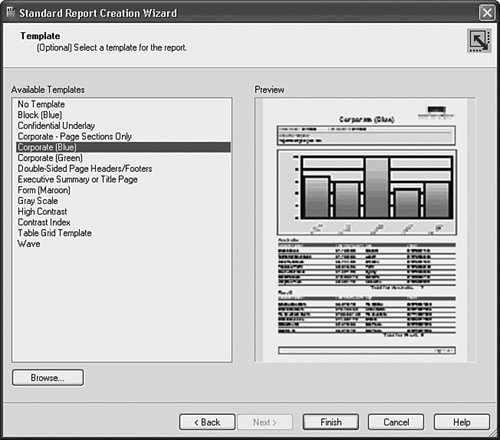
|
This now concludes the Standard Report Creation Wizard example. After you click Finish, you will execute the report that you have just created and will be presented with the preview of the corresponding resultset. At this point, you can click Finish if you are satisfied with the report design criteria. When you are presented with the preview of your report, save your new report by selecting Save As from the File menu. Name this report Chap1Wizard.rpt or anything you would like. After you select Finish at the end of the Standard Report Creation Wizard process, you will be presented with the executed resultset and a preview of your newly created report. As Figure 1.26 shows, creating a useful and professional-looking report is extremely simple when using the Standard Report Creation Wizard. In the preceding exercises, you have connected to a database, identified the tables and fields you wanted to include in your report, linked the tables together, grouped and summarized the data, sorted the data, applied filtering criteria, included a chart object for enhanced visualization of the report results, and applied a report template for quick and easy formattingall in just a few clicks of your mouse! This process speaks both to the ease of use and power of the Crystal Reports design application. Figure 1.26. The executed resultset and preview of the report you have just created using the Standard Report Creation Wizard. 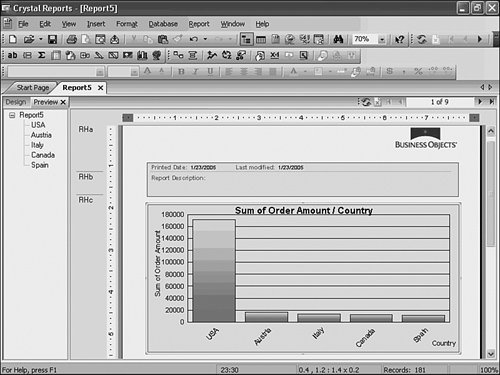
|













